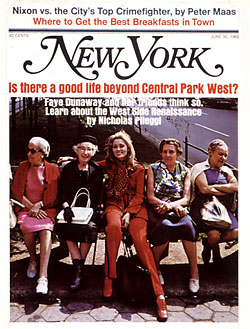 |
From the June 30, 1969 issue of New York Magazine.
Five years ago the West Side of Manhattan was considered such a dangerously blighted area that invitations to parties on Riverside Drive were often rejected, large rent-controlled apartments were voluntarily given up and even Chicken Delight wouldn't deliver. Today, while many of the area's most critical problems remain, an unmistakable mood of confidence has replaced earlier premonitions of doom. Merchants, real-estate men, bankers, theatre owners, city planners, restaurateurs, newsdealers and the trustees of private schools all agree with what Mayor John V. Lindsay admits privately: "The Upper West Side is probably enjoying more of a renaissance today than any other single neighborhood of our city."
In the 64-block-long area west of Central Park between Columbus Circle to the south and Columbia University to the north, the evidence is visible. Not only are there new low-and middle-income housing developments now where the rubble of abandoned buildings and slums stood just five years ago, but hundreds of the area's crumbling rooming houses have been renovated to accommodate increasing numbers of middle-class tenants, and even a few of the neighborhood's middle-European rococo hotels have been steam-cleaned. The same kind of young, successful and relatively affluent middle-class families that moved to the suburbs 20 years ago and to the East Side 10 years ago are moving to the West Side today, and while the neighborhood still has an ample supply of teenage muggers, parading homosexuals and old men who wear overcoats in July, the over-all mood of the area seems to have changed.
More baby carriages are in evidence; young, long-haired lovers are sharing park benches with elderly socialists; hiphuggered mothers are getting fewer dirty looks from resident matriarchs; tall blonde girls in pantsuits are suddenly bouncing down Columbus Avenue; there are see-through blouses in the windows of stores that used to display black crepe dresses and pillbox hats, while borzois, miniature poodles and Basenjis are beginning to outnumber the mongrels. Some of the new West Siders have moved back to the city from the suburbs, others have moved to escape the high rents of the East Side or the small apartments of Greenwich Village, Chelsea and even Brooklyn Heights. Many insist the area offers better housing values, transportation (70 per cent of all Manhattan public transit is on the West Side) and park space (twice as much as the East Side). The West Side is flanked by Central Park on its east-and the 266-acre Riverside Park on its west. Having the two parks within four crosstown blocks of each other (nine blocks separate Central Park from the largely commercial riverfront on the East Side) has encouraged movement through the area, despite the fact that stories of muggings and burglaries cast a paranoiac pall over much of the community.
"I was ready for war," one recent brownstone buyer said. "You know, German shepherd, barbed wire, burglar alarms, punji sticks, the works. But we were delighted to find that with a little caution it could be a relaxed place to live."
Statistically the West Side's 1968 crime figures place the area in the unenviable top third of the city's 76 precinct-house totals. The 20th Precinct on West 68th Street and the 24th on West 100th encompass most of the Upper West Side, and their combined records show 36 homicides, 86 forced rapes, 8,478 burglaries, 1,097 felonious assaults, 3,233 robberies (muggings and stickups) and 6,762 larcenies (mostly pocketbook snatches) last year. The bulk of the West Side's street crime today is the work of roving bands of 14-to-20-year-olds who mug, jostle and threaten their victims around or near the neighborhood parks during the evening and early morning hours. The effect of these crimes, committed, it sometimes seems, on everyone, or at least a friend or relative of everyone on the West Side, has been to create an atmosphere in which sudden noises produce quick frightened looks.
The Upper West Side is awake. A few years ago even flowers didn't want to grow there, but today a $700 million building boom has (almost) everything coming up roses.
Business, of course, has joined and helped to stimulate the movement to the West Side. Flower vendors who set up their cardboard cartons at the top of the neighborhood's subway stairs claim business is booming.
"Only a year ago," Monroe, a West 86th Street vendor, said between sales, "flowers couldn't live on the West Side."
Many of the new storekeepers who have moved into shops along Columbus and Amsterdam Avenues say that just a year ago they could not have survived. Jane Wilson, who in February opened a relatively expensive quality catering business called The Party Box on Columbus Avenue at 86th Street, admits that much of her business comes from the brownstone and luxury-apartment families who are as new to the neighborhood as she is. The bedpan, truss and traction medical supply stores that used to blanket the West Side have been replaced by youthful boutiques (Charivari, Free Expression, ICC Sound Union, Creations 'n Things, The Looking Glass), bookstores, theatres, antique shops, and a proliferation of moderately priced Cuban, Japanese, Thai, Italian, French, Indian, Egyptian and Israeli restaurants. New stores, like a dazzling unisex boutique, have even opened in what was once a commercial no-man's-land on Broadway between 105th Street and Columbia University.